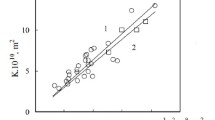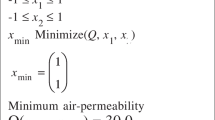Abstract
In this work, a series of needle-punched nonwoven fabrics was prepared by mixing polyester fibres of circular and deep-grooved cross-sections at different mass proportions and evaluated for their mean fibre shape, pore diameter and air flow behaviour. A simple and easy-to-use expression was developed for prediction of mean fibre shape in nonwoven fabrics prepared by mixing of fibres of different cross-sections. The mean fibre shape factor was found to be a weighted arithmetic mean of the shape factors of individual fibre components, where the weightage was determined by the product of volume and fineness fractions of individual fibre components. The nonwoven fabric prepared by circular fibres alone displayed the highest pore diameter, while the nonwoven fabric prepared by deep-grooved fibres alone exhibited the lowest pore diameter. The pore diameter was found to increase non-linearly with an increase in mass proportion of circular fibres in the nonwoven fabrics. The relationship between fibre shape and pore diameter was theoretically derived and experimentally verified. The air flow behaviour of nonwoven fabrics was found to be explained by Darcy’s law reasonably well. The nonwoven fabric prepared by circular fibres alone exhibited the highest air permeability, while the nonwoven fabric prepared by deep-grooved fibres alone displayed the lowest air permeability. The air permeability was found to decrease with a higher proportion of non-circular fibres in the nonwoven fabrics. This behaviour could not be explained reasonably well by Hagen-Poiseuille’s equation, however. But when the Reynolds number and the friction factor were taken into account, the predicted results were found in close agreement with the experimental ones.
Similar content being viewed by others
References
G. W. Jackson and D. F. James, Can. J. Chem. Eng., 64, 364 (1964).
G. E. R. Lamb, P. Costanza, and B. Miller, Text. Res. J., 45, 452 (1975).
G. E. R. Lamb and P. A. Costanza, Text. Res. J., 49, 79 (1979).
L. A. Clarenburg and R. M. Werner, Ind. Eng. Chem. Res., 4, 293 (1965).
V. K. Kothari and A. Newton, J. Text. Inst., 65, 525 (1974).
M. Tascan and E. A. Vaughn, Text. Res. J., 78, 289 (2008).
S. A. Hosseini and H. V. Tafreshi, Powder Technol., 212, 425 (2011).
G. E. R. Lamb and P. A. Costanza, Text. Res. J., 50, 362 (1980).
B. Neckář and D. Das, “Theory of Structure and Mechanics of Fibrous Assemblies”, Woodhead India Publishing Pvt. Ltd., New Delhi, 2012.
B. Neckář and S. Ibrahim, Text. Res. J., 73, 611 (2003).
I. M. Hutten, “Handbook of Nonwoven Filter Media”, Elsevier Ltd., Oxford, 2007.
R. E. Collins, “Flow of Fluids Through Porous Materials”, Pennwall Books, New York, 1961.
Author information
Authors and Affiliations
Corresponding author
Rights and permissions
About this article
Cite this article
Das, D., Ishtiaque, S.M. & Das, S. Influence of fibre cross-sectional shape on air permeability of nonwovens. Fibers Polym 16, 79–85 (2015). https://doi.org/10.1007/s12221-015-0079-9
Received:
Revised:
Accepted:
Published:
Issue Date:
DOI: https://doi.org/10.1007/s12221-015-0079-9




